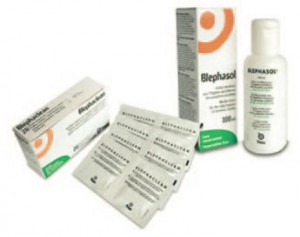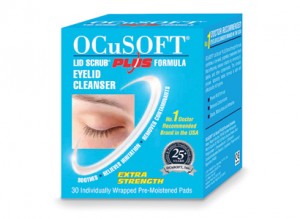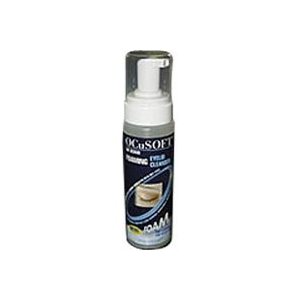Lid hygiene
In mild cases, all you need to do is clean your eyelid margins once a day. In more severe cases, you will need to first use a warm compress to melt the oil secretions, then massage the top eyelid downwards (and the bottom eyelid upwards) to milk the oil secretions onto the lid margin. A useful warm compress is a hot flannel (not too hot!) placed over the closed eyes for 2 minutes whilst lying down. The lid margin can then be cleaned using one of the following agents. I currently recommend Ocusoft but over the years the following have been used:-
i) Bicarbonate of soda
To make up, place half a teaspoon of bicarbonate into a cup of warm boiled water. It doesn’t dissolve very well but will provide an effective lid cleaning agent.
ii) Baby shampoo
This shampoos your eyelashes and helps clean and de-oil the lid margin. Place a teaspoon of the shampoo into a cup or boiled water and mix to develop a lather. Some patients do well with this, but others find it quite astringent and it can make some people’s blepharitis worse.
iii) Lid-Care
This is a proprietary agent for blepharitis that comes in two forms. The first is a pre-moistened pad and the second a solution in a bottle. The wipe is more expensive, but can be used directly to wipe the eyelid margin clean. The second is a solution that should be applied either with cotton-wool or with a Q-tip or cotton bud before the eyelid margin is cleaned.
Lid-Care can be purchased from high street pharmacists.
iv) Blephasol/blephaclean
These can be obtained over the Internet by googling Blephasol and going to the Spectrum-Thea website which in itself is quite informative about blepharitis. These are preservative free alternatives to Lid-Care. Some patients prefer blephasol/clean while others prefer the above solutions but many patients swear by blephasol.
v) OCuSOFT
This is the latest series of products that have become available and these are used extensively in the USA. They come in either moistened wipes or in the form of a foam which is squirted onto a eyelid make-up remover eye pad and used to massage the closed eyelids for about 30 seconds. A stronger version with an anti-bacterial agent called OCuSOFT Lid Scrub PLUS is also available for short courses in patients with particularly bad blepharitis.
I recommend starting with 2 weeks use of OcuSoft Plus pre-moistened wipes which are used twice a day to scrub the lashes. After wiping the lid margin, don’t rinse off as the Plus preparation contains PHMB, an anti-bacterial agent, which helps reduce the eyelid inflammation. After 2 weeks, use the Foam solution on an eye make-up remover pad to clean the lid margin. This is a detergent which cleans the oil secretions away from the lid and should be rinsed off after use.
Heat
If you have very bad blepharitis with a lot of crusting around the lashes, using the heated steam goggles sold by Spectrum-Thea can be beneficial. Over half of the patients I have recommended use these have got huge relief of symptoms but you have to pay for them! (Cost around £100).
Antibacterial agents
Both ointments applied to the lid margin directly and tablets taken by mouth are used for treating blepharitis in patients in whom an infective component is active.
Ointments are by definition quite greasy and will blur your vision is applied directly to the conjunctival sac by squeezing the tube. Instead, a small amount of the ointment onto a cotton bud and use this to apply the ointment sparingly to the lid margin. Only a small amount needs to be used usually 2 to 3 times a day for 2 to 4 weeks. Antibiotics have to be given for a longer time in blepharitis as the oily secretions decrease penetration of the antibiotic to their desired site of action.
In some patients, 1 -3 month courses of antibiotic are given by mouth. In some adults, low dose oral antibiotics (tablets) are needed for 3 months and in children, several years of treatment (usually up to puberty) may be required.
Anti-inflammatory agents
Steroid drops and ointments are sometimes required to try and break the cycle of recurrent inflammation that is found in patients with blepharitis. These can be given either as drops or combined with an antibiotic in an ointment.




